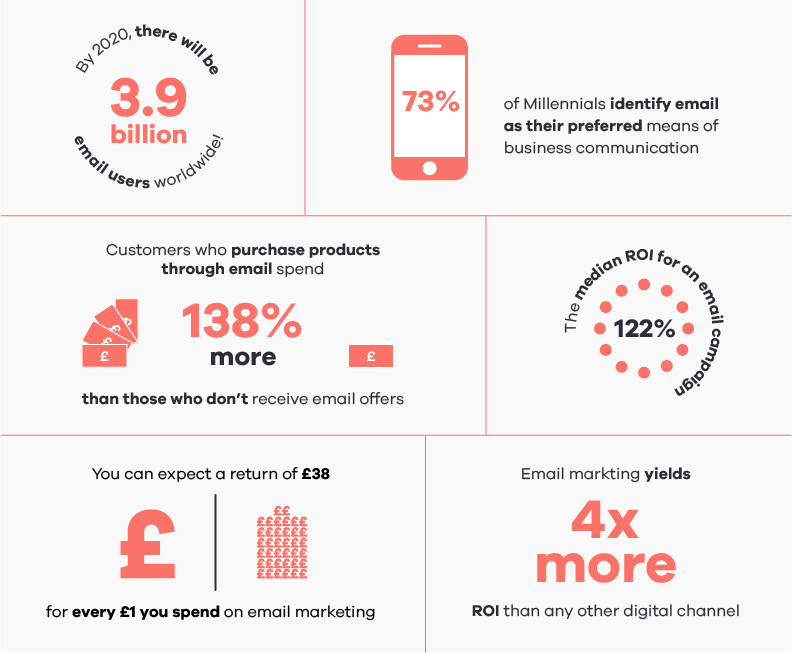Email marketing is a digital strategy. It involves sending emails to customers.
What Is Email Marketing And Why Is It Important? Email marketing helps businesses connect with their audience. It’s a cost-effective way to share news, promotions, and updates. Companies use it to build relationships and drive sales. Emails can be personalized to target specific groups. This makes them more effective than general ads.
The importance of email marketing lies in its direct approach. Emails land straight in a customer’s inbox. This ensures the message is seen. Also, it offers measurable results. Businesses can track open rates and clicks. This data helps in refining future campaigns. Overall, email marketing is a vital tool. It keeps customers engaged and informed.

Credit: think3.co.uk
Introduction To Email Marketing
Email marketing is a powerful tool for businesses. It helps them connect with their audience and build relationships. It’s cost-effective and has a high return on investment. Let’s explore what email marketing is and its importance in today’s digital world.
Definition Of Email Marketing
Email marketing involves sending commercial messages to a group of people using email. These messages can include newsletters, promotions, announcements, and updates. The goal is to keep the audience informed and engaged with the brand.
Email marketing can be personalized. Businesses can tailor messages to individual recipients based on their preferences and behaviors. This makes it more effective in capturing the audience’s attention.
Brief History
Email marketing has a rich history. The first email was sent in 1971 by Ray Tomlinson. It wasn’t until the late 1990s that email marketing became popular.
In the early days, email marketing was simple. Businesses sent out mass emails without much personalization. Over time, technology advanced. Email marketing has become more sophisticated. Today, companies use advanced tools and techniques to create targeted email campaigns.
Modern email marketing is highly effective. It uses data to understand the audience better. This allows businesses to send the right message at the right time.
| Year | Milestone |
|---|---|
| 1971 | The first email sent by Ray Tomlinson |
| Late 1990s | Email marketing gains popularity |
| 2000s | Introduction of advanced email marketing tools |
| Present | Data-driven and personalized email campaigns |
- Cost-effective
- High return on investment
- Personalized messages
- Engages the audience
Email marketing continues to evolve. It remains a key strategy for businesses. Understanding its history helps us appreciate its impact and potential.
Types Of Email Marketing
Email marketing is a powerful tool for businesses. It helps reach and engage with customers directly in their inboxes. Various types of email marketing exist, each serving a unique purpose. Understanding these types can enhance your email marketing strategy. Here are the main types of email marketing.
Promotional Emails
Promotional emails focus on products or services. They announce sales, special offers, or new product launches. These emails aim to drive sales and increase revenue. They often include a strong call-to-action, urging recipients to make a purchase. Businesses use these emails to boost their marketing campaigns.
Transactional Emails
Transactional emails provide essential information. They confirm orders, notify shipping details, and provide account updates. Customer actions trigger these emails. They ensure the customer experience is smooth and informed. Customers expect these emails, making them highly valuable for maintaining trust.
Lifecycle Emails
Lifecycle emails nurture customer relationships over time. They are tailored to different stages of the customer journey. Welcome emails greet new subscribers. Birthday emails offer special discounts. Re-engagement emails win back inactive customers. These emails build loyalty and encourage long-term engagement.
Key Components Of Effective Emails
Email marketing is a powerful tool for businesses. To succeed, your emails need to be effective. This means they must capture attention and drive action. Let’s explore the key components of effective emails.
Compelling Subject Lines
The subject line is the first thing your recipient sees. It should grab their attention immediately. Use clear and concise language. Avoid spammy words like “free” or “act now.” A good subject line can increase your open rates.
Personalization
Personalized emails make your recipients feel special. Use their names in the greeting. Segment your email list based on preferences. Tailor the content to meet their needs. Personalization improves engagement and builds trust.
Clear Call-to-action
Your email should have a clear call-to-action (CTA). Tell your readers exactly what you want them to do. Use action words like “buy,” “sign up,” or “learn more.” Make the CTA button stand out with bright colors. A clear CTA increases the chances of conversion.
Benefits Of Email Marketing
Email marketing offers significant advantages for businesses of all sizes. It allows companies to connect with their audience directly. Let’s explore the key benefits of email marketing.
Cost-effectiveness
Compared to other marketing channels, email marketing is cost-effective. No printing fees, no postage costs. Sending an email is much cheaper than sending physical mail. You can reach thousands of people with one click. This helps small businesses compete with more prominent companies. Email marketing software often comes with free or low-cost plans. So, you get a lot of value for a small investment.
High Roi
Email marketing delivers a high return on investment (ROI). According to studies, the average ROI is $42 for every dollar spent. This makes email marketing one of the most profitable marketing strategies. You can track performance easily. Open rates, click-through rates, and conversions are all measurable. This allows you to refine your strategy for even better results.
Targeted Messaging
Email marketing allows for targeted messaging. You can segment your audience based on various factors. Some examples are age, location, purchase history, and interests. This ensures your message is relevant to each recipient. Relevant messages lead to higher engagement rates. People are more likely to open and read emails that interest them. This helps build a stronger relationship with your audience.
Building An Email List
Building an email list is a crucial step in email marketing. It allows you to reach out directly to your audience. An effective email list can improve engagement and drive conversions. This section will cover the essentials of building an email list.
Opt-in Forms
Opt-in forms are vital for collecting email addresses. These forms are placed on your website. They invite visitors to subscribe to your newsletter or updates. Keep the forms simple and easy to fill out. Ask only for necessary information like the email address and name.
- Use clear and compelling call-to-action (CTA) buttons.
- Place forms in visible areas like the homepage or blog posts.
- Ensure the design is user-friendly and mobile-responsive.
Lead Magnets
Lead magnets are incentives offered to users for their email addresses. These can be eBooks, checklists, or discount codes. Offering something valuable increases the chances of users subscribing.
| Type of Lead Magnet | Description |
|---|---|
| eBook | Could you provide in-depth information on a topic? |
| Checklist | A simple, actionable list of tips or steps. |
| Discount Code | Offer a discount on your products or services. |
Ensure the lead magnet aligns with your audience’s interests. Make it easy for users to download or access.
Segmentation
Segmentation involves dividing your email list into smaller groups. This allows for more personalized and relevant content. Segmentation can be based on various criteria.
- Demographics: Age, gender, location.
- Behavior: Purchase history, website activity.
- Preferences: Interests, content preferences.
Segmented email lists lead to higher open and click-through rates. Could you tailor your emails to match the needs of each segment?

Credit: 2stallions.com
Email Marketing Tools
Email marketing tools are essential for creating, managing, and optimizing email campaigns. These tools provide features that simplify the process, improve efficiency, and enhance the overall effectiveness of your email marketing strategy. Below are some key types of email marketing tools that can help you achieve your goals.
Automation Platforms
Email automation platforms allow you to create automated email sequences. These can be triggered by specific actions, such as signing up for a newsletter or purchasing. Here are some popular features:
- Autoresponders: Automatically send a series of emails based on user actions.
- Drip Campaigns: Schedule emails to be sent over time.
- Segmentation: Divide your email list into different groups for targeted messaging.
Analytics Tools
Analytics tools provide insights into how your email campaigns are performing. They help you track important metrics to measure success. Common features include:
- Open Rates: Measure how many people open your emails.
- Click-Through Rates: Track how many clicks your email links receive.
- Conversion Rates: See how many users take the desired action.
A table summarizing key metrics can be helpful to:
| Metric | Importance |
|---|---|
| Open Rates | Shows email engagement |
| Click-Through Rates | Indicates interest in content |
| Conversion Rates | Measures campaign success |
Design Software
Design software helps you create visually appealing emails. A well-designed email can attract attention and improve engagement. Key features include:
- Email Templates: Pre-designed layouts for quick customization.
- Drag-and-Drop Editors: Easily create designs without coding.
- Responsive Design: Ensure your emails look good on all devices.
Using these tools can significantly enhance the quality and effectiveness of your email campaigns. Choose the right tools to match your specific needs and goals.
Best Practices For Email Campaigns
Understanding the best practices for email campaigns is crucial for achieving success. By following these guidelines, marketers can ensure their messages reach and resonate with their audience effectively. Let’s dive into some key practices that can make your email campaigns more successful.
A/b Testing
A/B testing is a powerful tool for optimizing email campaigns. This process involves sending two different versions of an email to a small segment of your audience. By analyzing the results, you can determine which version performs better.
Consider testing:
- Subject lines
- Email content
- Call-to-action buttons
- Images and layouts
You can use the winning version for the rest of your audience. This way, you can continuously improve your email performance.
Mobile Optimization
Most people read emails on their mobile devices. Therefore, mobile optimization is essential. Please make sure your emails are easy to read on small screens.
- Use a responsive design
- Keep your subject lines short
- Use larger fonts
- Ensure buttons are easy to tap
By optimizing for mobile, you enhance user experience and engagement.
Compliance With Laws
Compliance with laws is not just about following rules. It’s also about building trust with your audience. Could you ensure your email campaigns comply with GDPR and CAN-SPAM Act regulations?
| Regulation | Requirement |
|---|---|
| GDPR | Obtain explicit consent from EU users |
| CAN-SPAM Act | Include a clear unsubscribe link |
Following these laws protects your brand and respects your audience’s privacy.
Credit: fluentcrm.com
Case Studies And Success Stories
Email marketing has proven its worth in various industries. Businesses of all sizes use it to connect with customers. This section highlights real-world examples. Discover how small businesses and large enterprises benefit from email marketing. Learn from their success stories.
Small Business Examples
Many small businesses use email marketing to grow. One local bakery, for instance, saw a 20% increase in sales. They sent personalized emails with special offers to customers. Another example is a boutique clothing store. They used email campaigns to announce new arrivals. Their customer base grew by 30% in just six months.
A small bookshop also found success. They used email newsletters to share book recommendations. Their engagement rates soared. Loyal customers returned to buy more books. These examples show how email marketing can boost small businesses. It can create strong customer relationships.
Enterprise Success Stories
Large enterprises also benefit from email marketing. A well-known tech company used it to launch new products. Their campaign reached millions of subscribers. Sales increased significantly. Another example is a global fashion brand. They used email marketing to promote seasonal sales. The result was a 25% rise in online purchases.
A major airline company used email campaigns for customer retention. They sent personalized travel offers. This increased their repeat bookings by 40%. These success stories show the power of email marketing for large enterprises. It can enhance brand loyalty and drive sales.
Future Trends In Email Marketing
Email marketing is evolving rapidly. Businesses need to stay updated to maintain effective campaigns. Here are some future trends in email marketing to watch.
AI and Machine Learning
AI and machine learning are transforming email marketing. These technologies analyze customer data to create personalized content. This leads to higher engagement rates. AI can predict the best times to send emails. It also helps in segmenting your audience more accurately. Machine learning improves the efficiency of your campaigns. It can identify patterns and suggest improvements.
Interactive Emails
Interactive emails are becoming popular. They engage users more effectively. Elements like polls, quizzes, and interactive images make emails more engaging. Users can interact with the content without leaving their inbox. This increases the chances of higher engagement. Interactive emails provide a better user experience. They keep your audience interested and involved.
Privacy And Data Protection
Privacy and data protection are crucial in email marketing. New regulations focus on protecting user data. Businesses must comply with laws like GDPR and CCPA. Transparency is key. Inform your audience about data usage. Obtain explicit consent before collecting data. Secure your data storage and processes. This builds trust with your audience and ensures compliance.
Frequently Asked Questions
What Is Email Marketing?
Email marketing is a digital strategy that sends emails to potential and existing customers. It’s used for promoting products, sharing news, and building relationships.
Why Is Email Marketing Important?
Email marketing is essential because it directly reaches your audience’s inbox. It helps boost engagement, drive sales, and build customer loyalty.
How Does Email Marketing Work?
Email marketing collects email addresses, creates engaging content, and sends targeted emails. These emails can include promotions, newsletters, or personalized messages.
What Are The Benefits Of Email Marketing?
Email marketing benefits include high ROI, direct customer communication, personalized content, and measurable results. It’s cost-effective and scalable.
Conclusion
Email marketing is crucial in today’s digital world. It helps businesses connect directly. You can reach your audience with personalized messages. This builds trust and loyalty. Consistent email campaigns drive engagement and conversions. They also provide valuable insights through analytics.
You can start using email marketing to grow your business. It’s practical, affordable, and easy to manage. Don’t miss out on this powerful tool. Your success depends on it.





